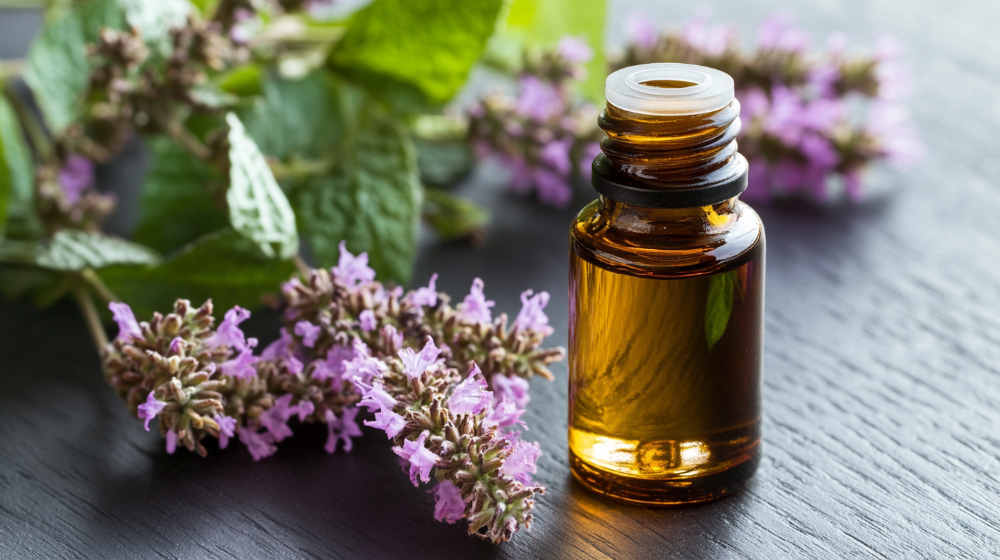Table of Contents - click here
TogglePatchouli essential oil has gained recognition in both traditional medicine and modern aromatherapy practices. The oil’s complex chemical profile contains sesquiterpenes and patchoulol compounds that contribute to its distinctive properties. While many users appreciate its earthy fragrance, the therapeutic applications extend far beyond its aromatic qualities. Understanding the proper extraction methods, safety protocols, and verified benefits requires examining the scientific evidence behind this Southeast Asian botanical extract.
Essential Takeaways
- Patchouli essential oil comes from Pogostemon cablin, a tropical plant native to Southeast Asia including Indonesia, Malaysia, and India.
- The oil contains patchoulol and sesquiterpenes that provide antimicrobial properties against bacteria like Staphylococcus aureus and E. coli.
- Leaves are harvested at 6-8 months when plants reach 30-45 cm height, then fermented 12-24 hours before distillation.
- For safe topical use, the oil must be diluted to 2-5% concentration with carrier oils to prevent skin irritation.
- The oil shows anti-inflammatory effects and stress-reducing properties when used in aromatherapy with 3-5 drops in diffusers.
Latin Name
The Latin name for patchouli essential oil is Pogostemon cablin (Blanco) Benth., with Pogostemon patchouli being a taxonomic synonym. The genus Pogostemon belongs to the Lamiaceae (mint) family.
Plant Origin and Harvesting
Native to tropical regions of Southeast Asia, patchouli (Pogostemon cablin) grows primarily in Indonesia, Malaysia, India, and the Philippines. The plant requires well-drained soil and temperatures between 24-28°C (75-82°F). Farmers harvest the leaves when plants reach 30-45 cm in height, typically 6-8 months after planting. Before distillation, the leaves undergo a fermentation period of 12-24 hours at controlled temperatures. Steam distillation of dried, fermented leaves yields 2-3% essential oil by weight. Indonesia produces approximately 550 tons of patchouli oil annually, representing more than 90% of global production.
Therapeutic Properties and Uses
Patchouli essential oil contains sesquiterpenes and patchoulol, which have demonstrated antimicrobial activity in laboratory studies. Research has confirmed its effectiveness against specific bacteria including Staphylococcus aureus and Escherichia coli. The oil requires dilution to 2-5% concentration with carrier oils for safe topical use. Clinical studies have documented anti-inflammatory effects through the inhibition of pro-inflammatory mediators. Aromatherapy applications typically use 3-5 drops in diffusers for therapeutic sessions. Double-blind studies on anxiety reduction remain limited, though preliminary research indicates potential stress-reducing properties. Dermatological applications must be monitored for contact sensitivity, as documented adverse reactions occur in approximately 0.5-2% of users.
Chemistry
The main compounds in patchouli essential oil (Pogostemon cablin) include patchoulol (patchouli alcohol) as the primary constituent, along with α-bulnesene, α-guaiene, and seychellene. These sesquiterpenes contribute to the oil’s characteristic earthy aroma.
| Chemical Constituent | Chemical Formula |
|---|---|
| Patchoulol | C15H26O |
| α-Bulnesene | C15H24 |
| α-Guaiene | C15H24 |
| Seychellene | C15H24 |
The exact percentages of constituents can vary based on factors including cultivation conditions, extraction methods, and plant maturity. Gas chromatography-mass spectrometry (GC-MS) analysis is used to verify the chemical composition of patchouli oil samples.
General Safety Info
Safe Use of Patchouli Essential Oil
Patchouli essential oil requires proper dilution and safety precautions for topical use. Standard dilution rate is 2% for general adult use (12 drops per 1 ounce/30ml of carrier oil).
Safety guidelines:
- Dilution: Mix with carrier oils like jojoba, almond, or coconut oil before skin application
- Patch testing: Apply diluted oil to inner forearm, wait 24 hours to check for reactions
- Medical consultation: Consult healthcare provider before use if pregnant, nursing, or taking medications
- Storage: Keep in dark glass bottles away from direct sunlight and heat
Potential skin reactions may include:
- Irritation
- Redness
- Itching
The oil should not be used:
- Undiluted on skin
- Internally without professional guidance
- On damaged or inflamed skin
- On children under 2 years old
Wrapping it Up
Patchouli essential oil, derived from Pogostemon cablin, offers documented therapeutic benefits through its sesquiterpene and patchoulol compounds. Its antimicrobial, anti-inflammatory, and stress-reducing properties make it valuable for aromatherapy and topical applications when properly diluted to 2-5% concentration. While generally safe for most users, proper precautions including patch testing and healthcare consultation remain essential, particularly for pregnant or nursing individuals. GC-MS analysis confirms its complex chemical composition responsible for therapeutic efficacy.





